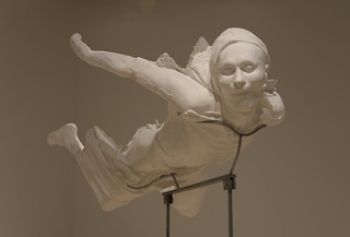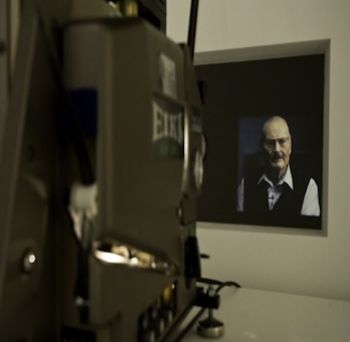Christine Borland & Kerry Tribe, Camden Arts Centre | reviews, news & interviews
Christine Borland & Kerry Tribe, Camden Arts Centre
Christine Borland & Kerry Tribe, Camden Arts Centre
Dead bodies inspired one artist, compellingly - the other makes dreary film
“As a student at Glasgow School of Art I used to visit the amazing anatomy, zoology and ethnographic collections at Glasgow University,” says Christine Borland. “I couldn’t understand why I was so intrigued, except for the question of how something so awful – so dead – could also be so beautiful. I was trying to unpick my responses, to understand how beauty and death could co-exist.”
Ever since graduating in 1987, she has been unpicking her responses to medical specimens and old bones in installations that attempt to confer dignity on the dead. When she acquired a human skeleton from the internet, she worked with a forensics expert to build up a picture of the deceased and used imaging technology to create a portrait bust of the victim. A young Asian woman, possibly murdered for her organs and bones, was thereby accorded the respect denied her in life.
Borland has been accused of poor taste and dubious morals, but ambiguity increases the potency of her work and encourages one to ponder uncomfortable moral issues. In the past, medical research was frequently carried out on the bodies of executed criminals. Borland’s eerily poetic installation at Camden, Cast From Nature (main picture), was inspired by a fibre-glass cast of a body displayed in Edinburgh’s Royal College of Surgeons. Sir John Goodsir, Head of Anatomy at Edinburgh University, partially flayed the corpse in 1845 and, presumably without irony, titled it From Nature and gave it a pose that mimics the dead Christ in Michelangelo’s Pieta of 1499.
Did he wish, through this extraordinary conceit, to compensate for the indignities meted out to the anonymous man, or did he hope the work would be favourably compared with that of the great sculptor? He evidently considered the figure to be a work of art rather than a medical specimen, which raises questions about the legal and cultural status of human remains.
Borland discovered a plaster cast of the same figure in the basement of Edinburgh’s Medical School, from which she was able to make a mould. For an exhibition at Glasgow Sculpture Studios, she constructed a set resembling a traditional anatomy theatre where audiences would have seen dissections taking place. Viewers were invited to watch a live broadcast of the mould being made in an adjacent room and, although Borland’s model was a plaster cast rather than an actual body, her actions come a close second to Sir John’s original interventions.
 Her exhibition at Camden is like the next step; analysis has given way to restitution. Static, lifeless and beautiful, the installation is more like a memorial than a post-mortem examination. Lying on an elegant steel support, the plaster cast throws back its head as though to reveal its flayed neck and abdomen; succumbing to gravity, the arms, legs, skin and loin cloth hang down – limp and lifeless. But the body has acquired a doppelgänger; the room is divided by a plaster curtain as though it were a chapel of rest, and on the other side, a second cast (pictured above) is displayed on a higher support.
Her exhibition at Camden is like the next step; analysis has given way to restitution. Static, lifeless and beautiful, the installation is more like a memorial than a post-mortem examination. Lying on an elegant steel support, the plaster cast throws back its head as though to reveal its flayed neck and abdomen; succumbing to gravity, the arms, legs, skin and loin cloth hang down – limp and lifeless. But the body has acquired a doppelgänger; the room is divided by a plaster curtain as though it were a chapel of rest, and on the other side, a second cast (pictured above) is displayed on a higher support.
It has been turned upside down, which reverses all the downward accents so the head, arms and legs are now raised and the skin and loincloth float upwards. The grimacing mouth seems to have morphed into a beatific smile and the blank eyes appear closed in a euphoric swoon reminiscent of the ecstasy of St Theresa as portrayed by Bernini. Borland’s simple act of reversal has transformed the inertia of death into the weightlessness of flight; apparently hovering on currents of air like a sky diver, the gleaming white cast now resembles an angel soaring through space. One would like to believe that this glorious ascension had released the soul from the unburied body, so that it could take flight and reparation could be accomplished at last.
Kerry Tribe’s installation is a pared-down version of an exhibition previously shown at the Arnolfini in Bristol. The American artist uses sound and film installations to explore potent subjects such as memory loss, gagging orders and the erasure of people and events from history. By all accounts, her work can be mysterious, engaging and thought-provoking and, if that is true, this dreary selection fails to do her justice.
 Spooling from one projector to another, a film produces two images 20 seconds apart. We watch as a middle-aged man known as patient HM (pictured left) fails to recall past events. In 1953, he underwent experimental surgery for epilepsy with disastrous results; removal of the hippocampus reduced his memory retention to a mere 20 seconds so that since the operation he instantly forgets everything. It is a moving story but, for obvious reasons, HM is not an engaging subject. For all its structural cleverness, the film reminded me of experiments in the psychology department of University College London, for which I volunteered in the 1960s; it was dull work but at least I got paid.
Spooling from one projector to another, a film produces two images 20 seconds apart. We watch as a middle-aged man known as patient HM (pictured left) fails to recall past events. In 1953, he underwent experimental surgery for epilepsy with disastrous results; removal of the hippocampus reduced his memory retention to a mere 20 seconds so that since the operation he instantly forgets everything. It is a moving story but, for obvious reasons, HM is not an engaging subject. For all its structural cleverness, the film reminded me of experiments in the psychology department of University College London, for which I volunteered in the 1960s; it was dull work but at least I got paid.
In Milton Torres Sees a Ghost, a length of audiotape travels along the wall between an oscilloscope and a tape recorder. American pilot Milton Torres recalls a UFO sighting over the North Sea in 1957. This is a historic moment, since his mission to destroy the intruder has recently been declassified; but since nothing came of the encounter, the event doesn’t set the heart racing.
The Last Soviet juxtaposes the fate of two cosmonauts. Sergei Krikalev went on a mission to the Mir space station in 1991, just before the USSR collapsed. Chaos on the ground forced him to spend 311 days drifting in space and he returned to find that his home town had been renamed St Petersburg and the Soviet Union had fallen apart. At least he retained his place in history, unlike a cosmonaut from the 1960s whose mission failed; as a result, the mission has been struck from official records and the man erased from photographs. The material is potentially interesting but Kerry Tribe’s dull presentations are like a rewind to the 1970s, when earnest conceptualists frequently equated dreariness with profundity. It makes YouTube seem inviting.
- Christine Borland & Kerry Tribe at Camden Arts Centre, London until 10 July
 Find Christine Borland on Amazon
Find Christine Borland on Amazon
The future of Arts Journalism
You can stop theartsdesk.com closing!
We urgently need financing to survive. Our fundraising drive has thus far raised £49,000 but we need to reach £100,000 or we will be forced to close. Please contribute here: https://gofund.me/c3f6033d
And if you can forward this information to anyone who might assist, we’d be grateful.

Subscribe to theartsdesk.com
Thank you for continuing to read our work on theartsdesk.com. For unlimited access to every article in its entirety, including our archive of more than 15,000 pieces, we're asking for £5 per month or £40 per year. We feel it's a very good deal, and hope you do too.
To take a subscription now simply click here.
And if you're looking for that extra gift for a friend or family member, why not treat them to a theartsdesk.com gift subscription?
more Visual arts
 'We are bowled over!' Thank you for your messages of love and support
Much-appreciated words of commendation from readers and the cultural community
'We are bowled over!' Thank you for your messages of love and support
Much-appreciated words of commendation from readers and the cultural community
 Kiefer / Van Gogh, Royal Academy review - a pairing of opposites
Small scale intensity meets large scale melodrama
Kiefer / Van Gogh, Royal Academy review - a pairing of opposites
Small scale intensity meets large scale melodrama
 Jenny Saville: The Anatomy of Painting, National Portrait Gallery review - a protégé losing her way
A brilliant painter in search of a worthwhile subject
Jenny Saville: The Anatomy of Painting, National Portrait Gallery review - a protégé losing her way
A brilliant painter in search of a worthwhile subject
 Abstract Erotic, Courtauld Gallery review - sculpture that is sensuous, funny and subversive
Testing the boundaries of good taste, and winning
Abstract Erotic, Courtauld Gallery review - sculpture that is sensuous, funny and subversive
Testing the boundaries of good taste, and winning
 Edward Burra, Tate Britain review - watercolour made mainstream
Social satire with a nasty bite
Edward Burra, Tate Britain review - watercolour made mainstream
Social satire with a nasty bite
 Ithell Colquhoun, Tate Britain review - revelations of a weird and wonderful world
Emanations from the unconscious
Ithell Colquhoun, Tate Britain review - revelations of a weird and wonderful world
Emanations from the unconscious
 Rachel Jones: Gated Canyons, Dulwich Picture Gallery review - teeth with a real bite
Mouths have never looked so good
Rachel Jones: Gated Canyons, Dulwich Picture Gallery review - teeth with a real bite
Mouths have never looked so good
 Yoshitomo Nara, Hayward Gallery review - sickeningly cute kids
How to make millions out of kitsch
Yoshitomo Nara, Hayward Gallery review - sickeningly cute kids
How to make millions out of kitsch
 Hamad Butt: Apprehensions, Whitechapel Gallery review - cool, calm and potentially lethal
The YBA who didn’t have time to become a household name
Hamad Butt: Apprehensions, Whitechapel Gallery review - cool, calm and potentially lethal
The YBA who didn’t have time to become a household name
 Bogancloch review - every frame a work of art
Living off grid might be the meaning of happiness
Bogancloch review - every frame a work of art
Living off grid might be the meaning of happiness
 Do Ho Suh: Walk the House, Tate Modern review - memories are made of this
Home sweet home preserved as exquisite replicas
Do Ho Suh: Walk the House, Tate Modern review - memories are made of this
Home sweet home preserved as exquisite replicas

Add comment